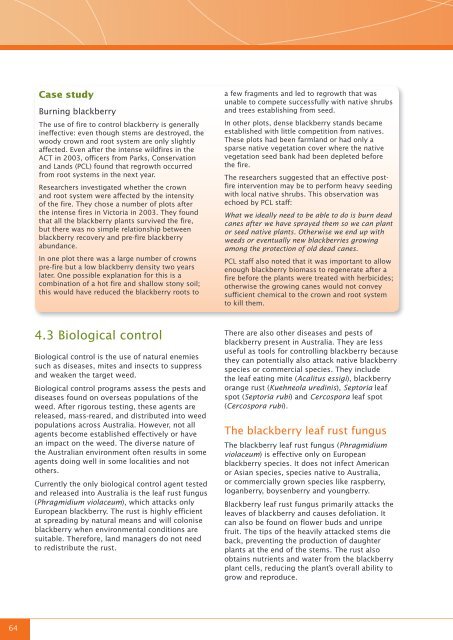Blackberry control manual - Weeds Australia
Blackberry control manual - Weeds Australia
Blackberry control manual - Weeds Australia
You also want an ePaper? Increase the reach of your titles
YUMPU automatically turns print PDFs into web optimized ePapers that Google loves.
Case study<br />
Burning blackberry<br />
The use of fire to <strong>control</strong> blackberry is generally<br />
ineffective: even though stems are destroyed, the<br />
woody crown and root system are only slightly<br />
affected. Even after the intense wildfires in the<br />
ACT in 2003, officers from Parks, Conservation<br />
and Lands (PCL) found that regrowth occurred<br />
from root systems in the next year.<br />
Researchers investigated whether the crown<br />
and root system were affected by the intensity<br />
of the fire. They chose a number of plots after<br />
the intense fires in Victoria in 2003. They found<br />
that all the blackberry plants survived the fire,<br />
but there was no simple relationship between<br />
blackberry recovery and pre-fire blackberry<br />
abundance.<br />
In one plot there was a large number of crowns<br />
pre-fire but a low blackberry density two years<br />
later. One possible explanation for this is a<br />
combination of a hot fire and shallow stony soil;<br />
this would have reduced the blackberry roots to<br />
a few fragments and led to regrowth that was<br />
unable to compete successfully with native shrubs<br />
and trees establishing from seed.<br />
In other plots, dense blackberry stands became<br />
established with little competition from natives.<br />
These plots had been farmland or had only a<br />
sparse native vegetation cover where the native<br />
vegetation seed bank had been depleted before<br />
the fire.<br />
The researchers suggested that an effective postfire<br />
intervention may be to perform heavy seeding<br />
with local native shrubs. This observation was<br />
echoed by PCL staff:<br />
What we ideally need to be able to do is burn dead<br />
canes after we have sprayed them so we can plant<br />
or seed native plants. Otherwise we end up with<br />
weeds or eventually new blackberries growing<br />
among the protection of old dead canes.<br />
PCL staff also noted that it was important to allow<br />
enough blackberry biomass to regenerate after a<br />
fire before the plants were treated with herbicides;<br />
otherwise the growing canes would not convey<br />
sufficient chemical to the crown and root system<br />
to kill them.<br />
4.3 Biological <strong>control</strong><br />
Biological <strong>control</strong> is the use of natural enemies<br />
such as diseases, mites and insects to suppress<br />
and weaken the target weed.<br />
Biological <strong>control</strong> programs assess the pests and<br />
diseases found on overseas populations of the<br />
weed. After rigorous testing, these agents are<br />
released, mass-reared, and distributed into weed<br />
populations across <strong>Australia</strong>. However, not all<br />
agents become established effectively or have<br />
an impact on the weed. The diverse nature of<br />
the <strong>Australia</strong>n environment often results in some<br />
agents doing well in some localities and not<br />
others.<br />
Currently the only biological <strong>control</strong> agent tested<br />
and released into <strong>Australia</strong> is the leaf rust fungus<br />
(Phragmidium violaceum), which attacks only<br />
European blackberry. The rust is highly efficient<br />
at spreading by natural means and will colonise<br />
blackberry when environmental conditions are<br />
suitable. Therefore, land managers do not need<br />
to redistribute the rust.<br />
There are also other diseases and pests of<br />
blackberry present in <strong>Australia</strong>. They are less<br />
useful as tools for <strong>control</strong>ling blackberry because<br />
they can potentially also attack native blackberry<br />
species or commercial species. They include<br />
the leaf eating mite (Acalitus essigi), blackberry<br />
orange rust (Kuehneola uredinis), Septoria leaf<br />
spot (Septoria rubi) and Cercospora leaf spot<br />
(Cercospora rubi).<br />
The blackberry leaf rust fungus<br />
The blackberry leaf rust fungus (Phragmidium<br />
violaceum) is effective only on European<br />
blackberry species. It does not infect American<br />
or Asian species, species native to <strong>Australia</strong>,<br />
or commercially grown species like raspberry,<br />
loganberry, boysenberry and youngberry.<br />
<strong>Blackberry</strong> leaf rust fungus primarily attacks the<br />
leaves of blackberry and causes defoliation. It<br />
can also be found on flower buds and unripe<br />
fruit. The tips of the heavily attacked stems die<br />
back, preventing the production of daughter<br />
plants at the end of the stems. The rust also<br />
obtains nutrients and water from the blackberry<br />
plant cells, reducing the plant’s overall ability to<br />
grow and reproduce.<br />
64

















